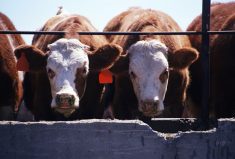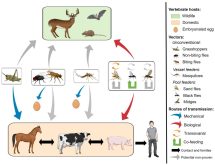The federal government now wants added certification on imports of live horses from the U.S., in the wake of an equine venereal disease turning up south of the border.
The Canadian Food Inspection Agency (CFIA) found before Christmas that farms in Ontario and Alberta received semen last spring taken from one of three Kentucky stallions that have since tested positive for contagious equine metritis (CEM).
The new certification requirements for live U.S. horses are a “precautionary response” to the CEM cases in the U.S., CFIA said in a release Friday, adding that it plans to have new import requirements for horse semen and embryos in place “in the coming weeks.”
Read Also

Tyson Foods to close U.S. beef plant as cattle supplies dwindle
Tyson Foods will close a beef plant in Lexington, Nebraska, with about 3,200 employees after U.S. cattle supplies dropped to their lowest level in nearly 75 years, the meatpacker said on Friday.
With the exception of horses from Florida, because of equine piroplasmosis in that state, live horses may continue to be imported into Canada from the U.S. without an import permit, CFIA said, but all U.S. horses will require a U.S. veterinary health certificate.
For all U.S. export certificates issued after Jan. 19, and for Canadian horses exported to the U.S. and returning on a Canadian health certificate issued after Jan. 19, the horse in question must not have been on a premises where T. equigenitalis (the bacteria that causes CEM) has been isolated during the 60 days before the export.
The same goes for horses that have been on premises currently under quarantine or investigation for CEM. Any females in a shipment bound for Canada must have not been bred naturally to, or inseminated with, semen from a stallion positive for CEM, or a stallion living on a CEM-positive property or property under quarantine or investigation for CEM.
The horses being shipped to Canada must also show no clinical signs of CEM on the day of inspection, CFIA said Friday.
These new certification statements related to CEM will go on the existing veterinary health certificate for live horses, CFIA said.
The certification will also be needed for imports to Canada of asses, mules and zebras as well as horses, but not for horses coming to Canada for immediate slaughter, the agency said.
High transmission rate
According to the U.S. Department of Agriculture’s Animal and Plant Health Inspection Service (APHIS), nine U.S. stallions have now been confirmed CEM-positive: three in Indiana, four in Kentucky and one each in Wisconsin and Texas.
Along with the nine positives, APHIS has also confirmed the location of 374 other exposed stallions and mares in a total of 42 states. All 383 animals are now under quarantine and a hold order. Another 97 exposed mares and one stallion are still “actively being traced.”
According to APHIS, clinical signs of CEM can include a vaginal discharge in up to 40 per cent of affected mares, as well as abortion and infertility. Stallions typically show no clinical signs.
Stallions and mares can become chronic carriers of CEM and be sources of infection for future outbreaks. The transmission rate is high and naturally occurs by mating, but contaminated instruments and equipment may be an indirect source of infecting mares and stallions. CEM bacteria can also be spread by way of semen collected for artificial insemination, APHIS said.














